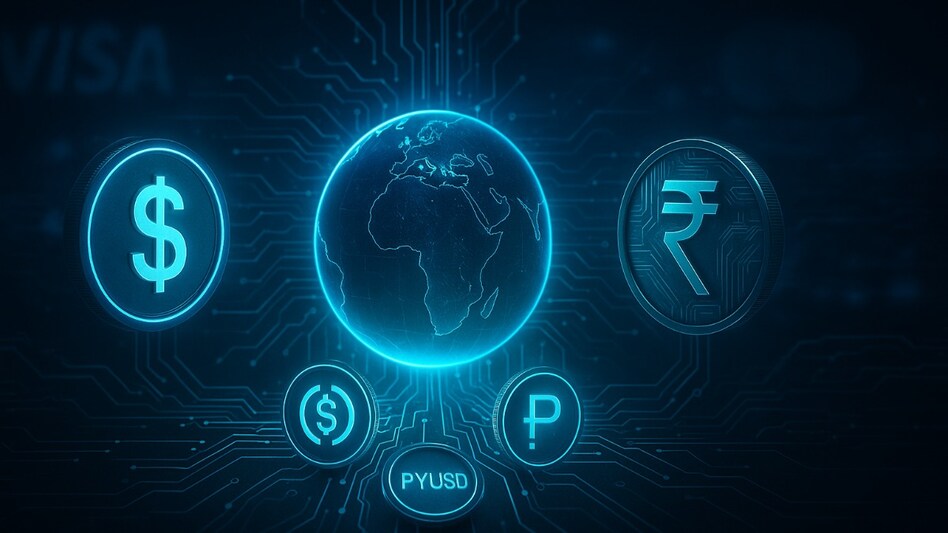 Representational image of stablecoins in the global financial battlefield
Representational image of stablecoins in the global financial battlefield
 Representational image of stablecoins in the global financial battlefield
Representational image of stablecoins in the global financial battlefieldFor decades, Visa and Mastercard have sat comfortably at the heart of digital payments, profiting from every swipe, tap, and online purchase. But today, a new class of financial instruments called stablecoins is threatening to upend their dominance by making payments cheaper, faster, and borderless.
These dollar-pegged cryptocurrencies are not speculative like Bitcoin. Instead, they’re designed to maintain a stable value, making them ideal for transferring money online, across borders, and even between machines, without the need for traditional banks or card networks. That means no interchange fees, no currency conversion delays, and no bank middlemen.
Now, as Big Tech, crypto giants, and central banks scramble to define the future of digital money, stablecoins have emerged as the flashpoint of a global financial war, one that could change the way billions move money.
What Are Stablecoins?
Stablecoins are digital assets typically pegged 1:1 to a fiat currency such as the US dollar (USD), euro (EUR), or Indian rupee (INR). Unlike volatile cryptocurrencies, their value is deliberately stabilised, either through fiat reserves (eg. bank deposits, Treasuries) or crypto-collateralised mechanisms.
Popular examples include:
These instruments aim to combine the best of both worlds: the trust of traditional money and the speed of crypto systems.
Why Stablecoins Are Behind a War in Global Payments
1. Big Tech and Fintech vs Traditional Finance
Large tech and commerce platforms like PayPal, Shopify, Telegram, and Amazon are actively exploring or deploying stablecoins. Their motivation? To cut out intermediaries and reclaim transaction margins traditionally consumed by banks, Visa, and Mastercard. For instance:
This disintermediation directly threatens the card networks’ revenue model. Visa and Mastercard are scrambling to integrate support for select stablecoins and blockchains like Solana and Ethereum to remain relevant.
2. Crypto Firms Go Legit—And India Watches Closely
In the United States, leading stablecoin issuers are seeking formal banking licenses to integrate with the regulated financial system.
The Indian Context: Opportunity Meets Caution
India is watching this development with keen interest, particularly because Indians receive more than $129 billion in remittances annually, paying high fees of 3–7% in the process, according to Artemis data.
Despite regulatory uncertainty under FEMA and RBI’s crypto stance, Indians are already using stablecoins informally for offshore payments and remittances, often via platforms operating in regulatory grey zones.
The Finance Ministry is now drafting a crypto discussion paper (expected July 2025) with a focus on stablecoins, recognising their potential for cross-border payments and financial inclusion.
SEBI has proposed a multi-regulator framework, with the RBI taking charge of stablecoins, while other agencies regulate broader crypto assets.
Though India has not licensed any private firm to issue a domestic stablecoin or hold reserves, officials are closely studying the US model, and industry leaders are lobbying for similar legal clarity. If USDC or RLUSD gains full federal backing and India builds a compliant framework, platforms could soon offer direct USD-to-INR stablecoin transfers, cutting out traditional banking delays entirely.
This could also pave the way for interoperability between India’s CBDC (e₹) and foreign stablecoins, creating a hybrid model of regulated digital finance.
3. A US-Centric Stablecoin Boom Sparks Global Pushback
While the US sees stablecoins as a way to extend dollar dominance into digital ecosystems, not everyone is thrilled. The EU’s Markets in Crypto-Assets Regulation (MiCA) restricts the circulation of non-euro stablecoins in Europe, aiming to preserve monetary sovereignty.
The Bank for International Settlements (BIS) and central banks in Asia have flagged stablecoins as systemic risks that could cause currency substitution and destabilise domestic monetary policy. India’s Reserve Bank of India (RBI) has echoed these concerns, with Governor Sanjay Malhotra cautioning against private issuers replacing sovereign currency, but the RBI’s approach has evolved from blanket resistance to controlled exploration.
4. CBDCs vs Stablecoins: Coexistence or Competition?
India is already piloting its central bank digital currency (CBDC), the digital rupee (e₹), in both wholesale and retail settings. It offers many benefits of stablecoins, but is centrally controlled and programmable.
Still, experts argue that CBDCs and stablecoins can coexist:
A clear, unified policy on stablecoin issuance, reserves, and compliance would allow India to unlock these use cases, especially for millions of migrants and SMEs.
Final Word
Stablecoins are no longer just a crypto experiment; they are reshaping the infrastructure of global money movement. From disrupting Visa and Mastercard, to forcing central banks to respond, to opening new possibilities for cross-border finance in India, the stablecoin revolution is well underway. Whether India chooses to embrace it as a regulated innovation or stifle it out of fear, the choice will shape how its people and businesses connect to the global economy in the digital age.
For Unparalleled coverage of India's Businesses and Economy – Subscribe to Business Today Magazine